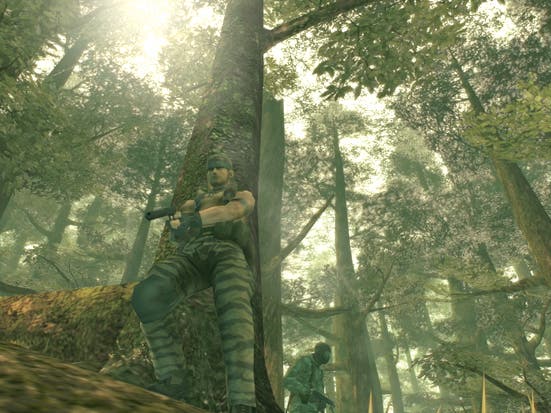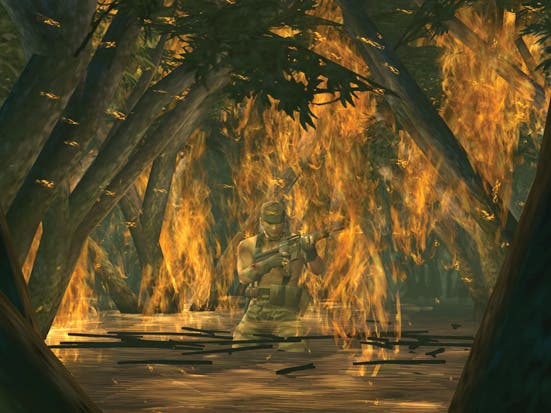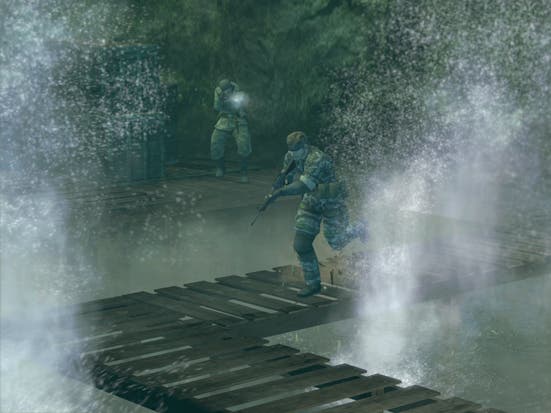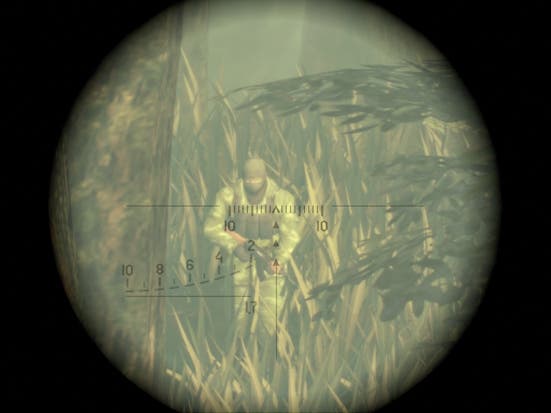Metal Gear Solid 3: Snake Eater
We've played it. We've played it a hell of a lot. We've written a hell of a lot about it. For some of us, this is the most important game of the show, and we have a feeling they'll appreciate it. There's a trailer for you to download, too!
Read the preview. Go on. But before you do, you might want to start downloading our high resolution video of the Metal Gear Solid 3 trailer, available from Eurofiles right now.
A few minutes into Metal Gear Solid 3, sitting through an easily ten-minute-long codec conversation in which our hero, dubbed "Naked Snake" for the purposes of this adventure, is discussing the finer points of an oriental proverb, it's clear that Hideo Kojima and his team at Konami aren't gunning to convert non-believers, nor to rally disenfranchised fans of the original who couldn't get on with the sequel. Judging by the contents of the "Trial Version" - a one-hour-long section equivalent in a narrative and scene-setting sense to the Tanker demo released prior to Metal Gear Solid 2 - and the neighbouring big-screen trailer, which is exciting crowds at one-hour intervals, there's just as much of the self-indulgence that riled a fair few when Sons of Liberty first came to market.

But for those of us that enjoyed MGS and its sequel from start to stop, the demo and the trailer will almost certainly reaffirm our commitment. Narratively, the sense of isolation, self-flagellation and of wanting to understand is there, and in gameplay terms, the much-vaunted Camouflage Index, stamina system, stalking, close quarters combat and jungle setting blend in as effortlessly as a blonde FOXHOUND op in a stolen terrorist outfit. Yet far from being gimmicky threequel additions, or arguably marginal and obvious improvements ala MGS2, these are serious additions to the MGS world - and it's very creditable to see KCEJ reworking rather than simply refining its craft.
Furthermore, it seems that fears surrounding the radar's absence were thoroughly unnecessary - whether it was down to neon overload or jet lag or what, we genuinely forgot there was a radar until after we beat the Trial Version for the first time. We should see it re-emerge in some interior sections, but there were none in the demo, and we didn't miss it. Seriously. Perhaps because in a sense it's compensated for by an enhanced ability to look around using the right stick (which can be used to probe Snake's immediate surroundings in third-person mode - oiling the wheels of stalking death without fully alleviating the fear of being seen) And by the time we finished watching the trailer for the umpteenth time, witnessing many of the game's subtleties and later stages, and started to realise how, for example, Ocelot and Snake's histories and even idiosyncrasies are inextricably intertwined, there was no greater urge than to get hold of the final version and lock ourselves away with it.
"This could be hotter than Cuba"
It all begins as a military gunship cuts a path through the clouds over a mountainous jungle region of Soviet Russia. Inside, a lone United States operative with a familiar face sucks on a cigar and ignores an order to extinguish it. We know he won't. Moving through the plane, we encounter an authoritative looking and sounding military man with a pronounced chin, who works from a radio frequency of 140.85... Helping him direct a plainly covert action are two women called The Boss (identified as this-era-Snake's mentor, and guardian of combat technique advice) and Para-Medic (as in, cough, 'parachute medic', who offers medical and survival tutelage).
It's all directed in typically MGS style, with lots of cutting between close-up shots of each character as they expose the basic framework of the mission - to go in to the jungle and try and rescue a Russian scientist who wishes to defect - and cinematic licks like a slow motion shot of our ash-chomping hero flicking his cigar past the camera and then treading it into the deck as the wind catches it and sends it rolling back under his boot. To shed further light - we take the reins of an ancient Snake in the 1964, possibly even the template for the latter day progeny, who despite being identified as "Jack" briefly in an exchange with The Boss, is quickly rebranded "Naked Snake" by the man in charge, who opts for the call sign "Major Tom".
Snake is working for FOX unit, but the indication is that he's rather new to this and it's been a while since he's been out in the field. Typically he gets there with a bang, performing "the world's first HALO jump" (the high-altitude, low-opening jump - an obvious nod to Kojima's James Bond influences) into the jungle. His job, as we say, is to extract Dr Sokolov, a scientist who wishes to defect because he's become concerned about the nature of his work - seemingly revealed in the big-screen trailer as the inaugural Metal Gear, a tank that can deploy nuclear weapons on the go, and threatens to plunge the world into a nuclear conflict beyond the scope of the Cold War. Sokolov is being held in a rundown factory, but to get there Snake first has to traverse his way from the drop point, through jungle, swamp and factory and past alligators and various patrols. Along the way the game will teach us all its new tricks - and it's fair to say that after a few goes it has the same 'stealth-action sandbox' feel that many associated with the MGS2 Tanker demo after several hundred runthroughs...
Survival

Snake's first mission is to retrieve his backpack, which sheared off in the vicious descent, from a nearby tree. This introduces you to tree climbing, which is done simply by walking up to trees with a distinct ivy pattern and pressing action (triangle). Snake then climbs the tree (non-interactively) and perches like a tightrope walker on the branch, slowly edging along it as you direct him. By pressing the action button again, he can hang from the branch - later this will allow him to swing along it as if it were a railing or some other ledge, or hang in an iconic pose by one hand and wave his pistol around holding square, using the first-person view for precision. Pushing away from the branch also allows him to pounce silently from it, which will be useful later on for employing the game's stealthiest takedowns...
In the meantime though, Snake grabs his backpack - and for the purposes of the demo it's loaded with every tool we could imagine, including many of the game's weapons and tools (M16s, shotguns, pistols - with suppressors that wear out - directional microphones, motion sensors and other toys). With the 'pack equipped and a lengthy and explanatory codec sequence out of the way, our trip through the jungle refocuses its attentions on other new features. The stamina bar, for example, located at the top left of the screen along with our health meter, which depletes whenever we exert ourselves (hanging from a tree or railing will certainly do that), and has to be replenished by eating whatever food we can muster.
As we make our way around the jungle, we encounter various flora and fauna, all of which can be shot, at which point they sink to the ground and generate a familiar spinning ration box item to pick up. These items - be they harvests of anaconda, alligator, mushroom or even beehive - should be thought of as varyingly effective rations, and can be accessed from the Start menu "Survival Viewer," which also acts as a window to the contents of your inventory and allows you to fiddle with the Camouflage Index.
Invisible War
The Camouflage Index, of course, has been heavily trailed in the run-up to this demonstration, and typically it's very simple to use. The percentage bar in the top right of the screen shows how concealed we are and it's a figure derived from posture (standing/crouching/crawling/stalking), surroundings (long grass, brick wall etc) and how effective the current camouflage is in such surroundings. Changing camouflage to better suit the scenario proves very easy. By means of practice, we crouch in some long grass as if a patrolling enemy were approaching, and decide to try and up our percentage - crouched in our default digs at just 60 per cent, we'll likely be seen when anybody gets close enough.
Nipping into the Camouflage page of the Survival Viewer, we scan the list of alternate outfits and each has a plus or minus percentage figure next to it, giving us an idea of the value of switching to each outfit. Switching to Leaf Green adds 15 per cent, and adding face paint ups the effectiveness by a further five. Exiting, we go into sprawling position, and the game flicks to an unavoidable first-person view from within the grass - enhancing the tension no end - but our percentage is now at 95 per cent. Short of trampling on our heads, or seeing us move, a guard isn't going to find us hidden like this. It should come in useful.
We stop tinkering. There are no guards yet, so we start working our way further into the jungle, ever vigilant, until we come to a swamp. The swamp is populated by alligators, but thankfully no enemy soldiers. Deciding to try and avoid their attentions completely, we crawl down into the muddy bog, sneaking towards the opposite bank until - gah! - we sink into the mud very quickly, and Snake disappears into a filthy demise, leaving just a hand protruding from the surface. Hearing the familiar cries of "Snake? Snaaake!!" and being told that "Snake is dead; time paradox", we hit Continue and respawn just seconds earlier. Wading into the swamp this time, we sink to about waist height by the time we hit the opposite bank, emerging caked with mud. Changing or seemingly crawling through the grass will sort this out, but in the meantime we whip out our pistol and blast the nearest alligator. It uses up way too many bullets. Whipping out the shotgun - possessor of a shoulder jerking recoil - we take the alligator out in one blast, and it forms three rations.
How to kill a man

Exiting the swamp, Snake ducks down behind a tree and whips out his binoculars as the game shifts into a cut sequence, in which Major Tom and The Boss encourage him to avoid confrontation at all costs. Sorry guys; we've got other ideas. Holding R1 when prompted during the cut sequence gives us a view through the goggles, and it becomes clear that one patrol is moving between banks of earth towards our little clearing. We nip down the bank and flatten ourselves against a decaying tree trunk, charting the guard's approach by moving the right analogue stick upward. We glance down at the cards beneath our control pad in Konami's leafy MGS3 display and take note of the intricacies of the close quarters combat (CQC) system. Apparently the CQC system has been designed to allow us to combat multiple enemies quickly depending how close they are, and the controls are typical MGS fare. For the time being though, we're concerned with just one guard.
He moves into a wide circuit around our tree trunk, and by watching the turning of his head, we see our hiding spot slip out of his line of sight. It's at this point that we grasp the stalking system for the first time - general movement is MGS2-style with the left analogue stick, allowing us to creep by holding it to a certain degree and run by holding it the whole way. Cleverly though, the silent stalking move, which is slower but still slightly faster than the guard's patrol speed, is controlled using the D-pad, meaning that we never once run into the typical third-person game control problem of pushing the stick too far by accident.
With the guard arcing away, we move between trees at a quiet trot, then start to stalk him. We equip the knife. We close in, and as we move within a few feet, we hit the circle button. Our piteous subject doesn't know what hits him. What does hit him is a brutal combination of sleeper grab and handle smash to the skull, which spins him round and sends him tumbling into dirt that kicks up in sympathy as he topples and spinning stars indicate that he's well and truly knocked out. We could get used to this.
Factory records
Moving on, we race forward and tumble-roll (X) into some long grass, ducking down and quickly camouflaging ourselves using the intuitive Camo system. We wait. 95 per cent camouflaged. Then, just as our patrol is about to move past, our thumbs inexplicably betray us, jerking us forward and rustling the grass. "Huh?" Crap. We lie still, heart pounding. He watches closely, but we're barely even breathing on the end of the pad, let alone beneath the low-lying canopy of nature's finest. "Must be my imagination," he says dismissively, resuming his pattern. As the blood rushes back to our fingers, we stand up slowly and stalk towards him, before grabbing him as a shield, smashing him around the head with a pistol butt to send him tumbling to the dirt where we hold him up. He lies there with his hands on his head. It's all right. Have a tranquiliser dart in the head.
Working our way through the rest of the area, we use a combination of leaping and hanging from branches, hiding in long grass and within tree trunks to evade detection, and smack soldiers around with various weapons, even throwing them into trees to clobber them completely. We move on. Ahead of us is another patrolling guard, and a vast valley spanned by a rope bridge. Due to various guards on either side, we wind up playing this section multiple times, but it's worth it, as it exposes us to some of the subtler details - like the way the rope bridge loses some of its tethers in the face of automatic gunfire, and wobbles and sends us tumbling until we're hanging onto it from the side and having to haul ourselves back up.
With the bridge behind us, finally we're at the abandoned factory. This is a clever section. It's fenced in with barb wire meshes, has easily but satisfyingly navigable guard patrol routes, and a layout comprising barrels, natural camouflage elements and an open-topped and ruined building full of guards, crates, lockers and broken down bits of concrete to cover ourselves with. It's reminiscent of some of the most nerve-wracking and enjoyable areas of the previous Metal Gear Solid titles, and there are some impressive scripted options - hiding behind a barrel and rolling them down a bank to knock out a guard, for example.
Most wanted

Navigating this section is one of the most pleasurable aspects of the demo. The CQC gives us so many options, and the level of tension surrounded by so many guards is high. But unlike some sections of the previous titles, we are for once completely in control of our destiny. The right analogue stick can be moved around to give us a much wider view of our surroundings, the first-person view fills in the gaps, and the areas of long grass, red brick walls and other areas can be used in combination with our camouflage schemes to evade detection.
The system works a bit like lockers (and now logs) - if we duck into long grass and assume a 95 per cent camouflage rating, we won't be found unless someone treads on us, or if we're seen entering the grass. Of course, that won't stop enemies chucking grenades to probe our hiding spots. But, as long as we're well protected, we can generally sit out the quick 99-1 alert countdown, then the evasion counter, and longer (99 second) caution meter. Predictably, guards return to patrol points once the caution meter ticks down.
Making it from the entry point of the factory to the room in the north of the facility, penetrating the tight nest of guards and retrieving Sokolov using our various new tools to their fullest, what's most impressive is the sense that despite the change of setting this is an MGS game, with a large number of new ideas integrated in such a way that they feel like they belong. It's great to see it and play it, and although it's probably because we were such huge fans of both previous games, this one has crept to near the top of our most wanted list on the basis of what we've played.
Shaping things to come
And having seen Konami's lengthy trailer, we're now doubly wracked with impatience. Because it's clear from the trailer that as you attempt to escape from the factory and jungle with Sokolov, a young and familiar blonde-haired Russian from the "Ocelot" unit of Spezsnaz turns up, spinning an automatic pistol on his finger... In a brutal display of accuracy and efficiency, he takes down the guards surrounding Sokolov's prison - is he stealing Sokolov from his own army? Who is he working for? Before he can complete his mission though, Snake takes him down in vicious fashion, eliminating his backup one by one in a demonstration of finely honed martial arts easily comparable to any decent budget movie, and Snake gives him a little advice on his choice of weapon. Fans will want to watch the trailer to see it unfold.
The trailer is a bit harder to pick apart in terms of game structure from here on out though - Snake and Sokolov seem to escape, but they also seem to discover that Metal Gear is being transported, or perhaps miss their rendezvous (the plan had been to use a special balloon to extract them to the gunship, which would scoop them up and fly them out of Soviet airspace to safety - depending on your view, either another example of the script's attention to satisfyingly pointless detail, or its biggest flaw).
However the trailer does show us that a nuclear weapon explodes, introduces us to various characters including the Colonel, our ultimate adversary, who appears to have electricity pulsing through him and sports some fetching, Borg-implant style scars on his face and eyes; and a woman who seems to be the love interest - in fact, this mission appears to be when Snake's genetic make-up takes on its "love is only acceptable if it's part of the mission" mantra. It also sports plenty of rhetoric about how the mission is driven by "the times" rather than the people in temporary power, and there's a section at the end of the trailer that Raiden's many detractors (and particularly those who whinged that he looked like a girl) will adore...
From hide to seek

In gameplay terms though, the most interesting sections clue us in to alternative approaches to the factory section, and sections from later on in the game when Snake encounters enemies on what appear to be hovering riot shield units, stationary gun emplacements and helicopter battles, has to stalk a raised wooden cabin, terrorising the guards and splattering their brains with his sniper rifle, even... no, we won't say. Watch the trailer. One thing we can't hold our tongues about though is the flamethrower-wielding enemies that stalk Snake in the trenches, and the gorgeous fire effects that genuinely project heat visually through a blend of oranges, haze effects, and the liquid-like way the fire crawls along walls and flares up in the face of the camera. These flamethrower troops even shoot fire into a bunker, forcing Snake to leap out ablaze as if doused in burning alcohol, spraying bullets through gritted teeth into the bodies of his pursuers.
Snake is also seen stalking through what seems to be a beautifully realised mangrove swamp, the trees creeping up out of the water with some beautiful reflections as our riot shield flyer friends probe the swamp with searchlights - finding only his trusty alligator head mask concealing him beneath the surface.
Of all the impressive elements of the demo and trailer, this one reminds us of just one more - the sumptuous visuals. Within the trial version, the vision of a jungle is awesome. The meshes of colours and strewn items and general ambience is delightful, and the way Snake and other characters aren't so much shadowed as constantly flecked with patches of light peeking through the trees above is a subtle but important effect. And while the level of detail in the animations has always been inspiring, watching some of the takedowns and in-engine cut sequences unfold in MGS3 reminds you that it's not always the power of the hardware that dictates success; it's the artistic ability of the designers.
Solid
Overall, it's an overwhelming spectacle. Between the demo and the trailer, we know the game will turn away just as many as it did before with its vast codec sequences, but we have to admire Kojima's obsession with the detail, and those of you who share our passion for it have a lot to be thankful for. As its own adventure it has the potential to be a little bit impenetrable - despite taking place before the other titles, the biggest thrills are nostalgic and demand foreknowledge of certain events - but it's hard to argue with the team's design choices. The Camouflage Index, stamina system and CQC may have been heavily trailed in Konami's well-orchestrated PR campaign, but they're integral parts of this adventure rather than incongruous gimmicks. Aand it's an admirable example of how a sequel can sacrifice seemingly integral functions and benefit from the grafting of a host of new features rather than a mere couple - it's a level of progression that probably frightens a lot of publishers and perhaps even developers when it comes to revisiting popular franchises.
Ours is no mere technical admiration though - for fans of the series, Metal Gear Solid 3 is simply going to be the most exciting game at E3 this year, and when the PS2 magazines roll around in a month's time proclaiming that it "stole the show", they'll still be wrong, but we'll be tempted to let them get away with it this year. KCEJ deserves the acclaim.


.png?width=291&height=164&fit=crop&quality=80&format=jpg&auto=webp)




.jpg?width=291&height=164&fit=crop&quality=80&format=jpg&auto=webp)
